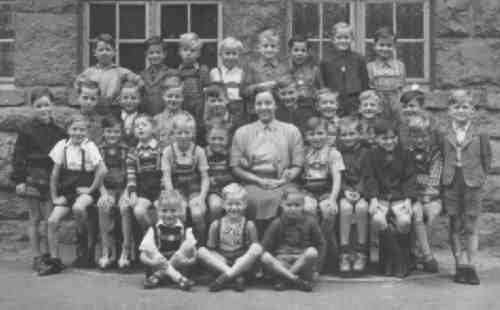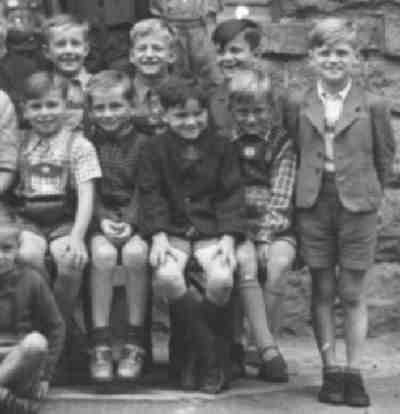
Figure 1.--The boys here mostly wear short pants. Suspender shorts and lederhosen were common. Several boys wear English-style school sandals. This appears to be a class of the younger boys at an elementary school.

HBC has very limited information on the clothes worn in elementary schools during the Third Reich. Except for the appearance of Hitler Youth uniforms, the clothes worn were quite similar to those worn during the Weimar Republic era (1919-32). Strangely, as uniforms were ordained for just about every one in NAZI Germany, school uniforms were not required for school children. Most boys wore short pants. During the colder winter months some boys wore long pants, but many wore shorts with kneesocks or long stockings. Lederhosen were common as were English style school sandals.
Dating some of the unidentified German images is difficult. Many clothing styles in the 1920s and 30s were quite similar. Thus HBC can not be sure that some of the images were from the Third Reich and not the Weimar Republic era.
German schools did not have dress codes. There no doubts were limits of some sort that would be informally opposed. Teachers were highly respected and any outlandish clothes would be questioned. There were few such incidents, however, as the range of clothing that could be worn to school was quite wide and few parents weould send their children to school in outlandish clothes, nor would the boys have wanted to wear such clothes. The clothes that were worn were the parent's choice. Schools did not, for example, require boys to wear shorts, that was simply ehat boys wore.
Boys began primary school at about 6 years of age. All children entered the Grundschule (4 years, but sometimes 6--then called „Förderstufe“ ). Thus most boys in primat school were about 6-10 years of age. This was formerly called Volksschule together with Hauptschule. Today it is the different (Bundes) Länder (federal countries), that tell how education should be, but during the NAZI era all children attended Grundschule. This was not a new system, buat a continuation of the system in placed during the Weimar era. Boys left primary school after 4 years. The academically clever boys went on to a gymnasium, a school like a British grammar school. This was an academically selective secondary school. Other boys went to Realschule that lasted 6 years and usually enter a „Lehre“ or apply for job. Or they have to go to Hauptschule (usually 5 years.

Figure 4.--While not common, some elementary bous would wear suit jackets to school. Note one boy wearing school sandals and another wearing one-bar sandals. |
Most of the school portraits we hve found show single gender classes. We note some mixed gender schools in rural areas.
Some of the clothing worn in German elementary schools during the Third Reich are discussed below. Boys wore a wide range of clothes. Little information is currently available on caps. During the War years (1939-45) military-styled caps became increasingly common. Some younger boys might wear sailor caps. Most school portraits, however, show the boys without their caps. Some boys dressed formally in suits of various description. Other boys dressed casually in sweaters and shirts. Boys wear a wide-variety of collared shirts. Most of the boys look to be wearing collared shirts. We see boys wearing both white and colored shirts. Patterned shirts were not very common. We do not see very many boys wearing checked shirts. Most boys in primary school wore short pants, some with kneesocks and others with long stockings. Quite a few boys wore suspender shorts. Lederhosen were also common, but still regional--concentrated in Bavaria and southern Germany. Boys during the summer mostly wear ankle socks. A few wear kneesocks, both dark colored, patterned and white kneesocks During the winter kneesocks are even more common. Some boys wear long stockings with shorts. Older boys might wear long pants thus the type of socks is not always apparent. The fashion of rolling down ones kneesocks which became fashionable in the late 1940s is not yet seen here. Boys wore a variety of shoes. We see many boys wearing heavy high-top shoes. Tennis (canvas shoes) are rare. During the summer many boys wear English-style school sandals. Most are the "T"-strap stle. A few boys wears the single-bar style, like strap shoes. We do not note open-toe sandals which became popular after the War. One common possession of many German school boys was a leather school satchel.
There were still some significant demographic trends at schools in the Third Reich. (After World war II these differences were to gradually disappear.). There could be substantial differences between schools in rural areas and city schools. Most city schools had single-gender classess. Coeducation was more common in small rural schools. The children also dressed less fashionably. Many of the children might be barefootbin the warm weather. We also notice boys with bowl cuts. Clearly mom was doing We are less sure about regional differences.
Many school boys in the 1900s and 10s would have their hair cropped military style. This was much less common after World war I in the 1920s. It does not seem to be a style, despite the military bent of the NAZIs that was approved of during the Third Reich. Boys tend to have short -back-and-sides hair cuts, but not cropped hair. We notice many boys in rural areas with bowl cuts.
Many school photographs are easily understood. The structure of German education was not significantly altered during the Third Reich. Thus the photographs require little explanation. We note some school photographs taken during the 1930s and 40s that we do not fully understand. Perhaps our readers will have some insights to offer.
Related Chronolgy Pages in the Boys' Historical Web Site
[Main Chronology Page]
[The 1910s]
[The 1920s]
[The 1930s]
[The 1940s]
Navigate the German school pages
[Main school uniform page]
[Main school uniform national page]
[Main German school uniform page]
[Imperial Germany]
[Weimar Republic]
[NAZI era]
[Post-war Years]
[Modern Germany]
